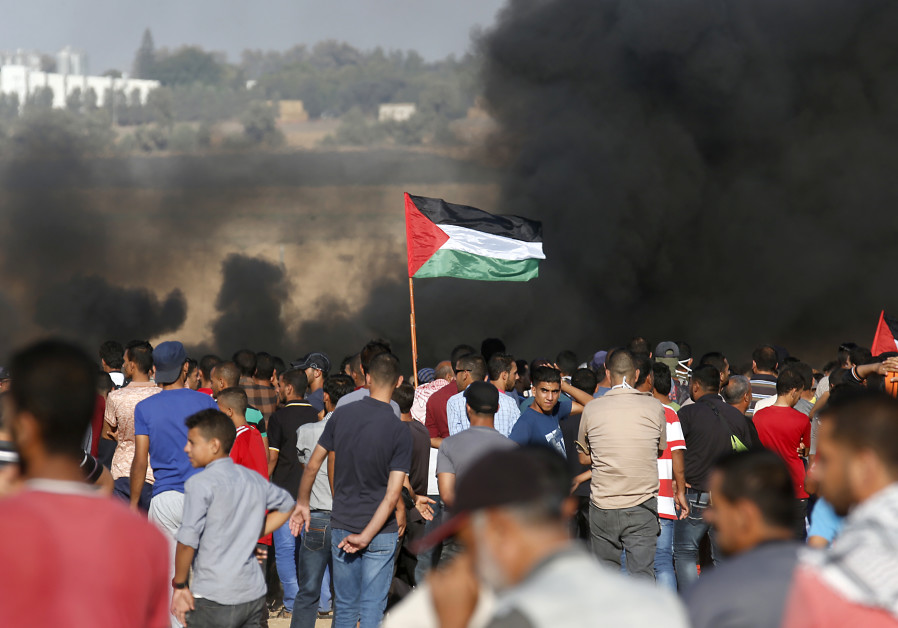ANALYSIS: Too many agendas in Gaza preventing quiet

Palestinian protesters wave their national flag as they gather during a demonstration at the Israel-Gaza border, in Khan Yunis in the southern Gaza Strip on August 10, 2018. (photo credit: SAID KHATIB / AFP)
The Gaza border was quiet on Friday afternoon until around three in the afternoon, when protesters and rioters began to gather at several points on the Palestinian side. It was the 28th week of protests since Hamas began sending groups of activists to the border on March 30. The massive protests are continuing amid rising tensions because too many regional states and leaders cannot agree on how to end the crisis.
Hamas is still talking about the “March of Return” it launched back in March. On Friday, another three were killed and 376 added to the list of those wounded in the clashes along the border. The Hamas-run Gaza Health Ministry said 197 people have been killed and more than 21,000 injured in the last six months.
The last weeks have added to the macabre totals. Five hundred and six people were injured on October 3 and seven were killed on September 28, according to reports. The numbers killed and wounded are larger than any similar period during the First Intifada. Hamas claimed on October 6 that it had “foiled a ‘conspiracy’ against Gaza.”
Ostensibly, the current conflict between Hamas and Israel is local. Hamas leader Yahya Sinwar told interviewer Francesca Borri recently, “There is a real opportunity for change. War is not our interest, but at the moment, an explosion is inevitable.”
The larger story is that there are several inter-related conflicts that connect Gaza to the region. Osama Hamdan, Hamas’s foreign policy head, told Al Jazeera, “Our experience with the Israelis has gone from bad to worse.”
“Israel does not want peace with us, it wants capitulation,” Hamdan said.
He also noted that the Palestinian Authority under President Mahmoud Abbas had not achieved Palestinian desires for a state.
But the reality of the current Hamas narrative is a product of its now isolated position. In the past, it felt that terrorism would defeat Israel. It thought this in the 1990s and during the Second Intifada, and read the Gaza disengagement as a victory for its side.
Hamas launched thousands of missiles into Israel and imported experts to help design longer range missiles, which reached their peak in the 2014 war. It built tunnels and trained naval commandos. At each juncture it thought that it could somehow break the siege imposed on it.
But the last years have proven difficult for Hamas. Isolated by the Trump administration, by regional powers, by Egypt’s border policies and by the Palestinian Authority, it is running out of options.
The mass protests were one option, and Hamas has sustained them beyond all expectations. However, the Associated Press reported that “Abbas has thwarted a series of internationally backed initiatives aimed at rehabilitating the Hamas-ruled Gaza Strip.” Trump’s Israel-Palestinian peace team of Jared Kushner and Jason Greenblatt have focused on Gaza. They have indicated that help for Gaza could come, but it’s up to Hamas.
This means that Abbas, who is also isolated, has placed himself astride the ability to deal with Gaza. There is fear in Ramallah that if Israel, the US and Hamas in Gaza come to some sort of agreement, it will further the separation of Gaza and the West Bank and bring legitimacy, even a sense of victory, to Fatah’s rivals in Gaza.
This Abbas-Hamas conflict has been playing out in Cairo amid endless discussions about reconciliation and also about avoiding escalation with Israel. In addition, Hamas recently accused the PA of blocking the transfer to Gaza of fuel purchased by Qatar.
A related problem is the break in relations between the US and Ramallah amid the Trump administration’s decisions to move the embassy and to cut aid to the Palestinians. And one cannot ignore the Turkish and Saudi Arabian roles in discussions about the Palestinians and Gaza.
In the past, Turkey has sought to play a role, including in discussions with Hamas and seeking to aid Gaza. Saudi Arabia also once played a more key role in discussions, but its close relations with the Trump administration and its dispute with Qatar have changed calculations.
In this context of disputes – Israel-Hamas, PA-Hamas, Qatar-Saudi Arabia, Turkey-Israel, Egypt-PA-Hamas – Gaza has become a conflict whose untangling appears increasingly difficult. In Jerusalem there have also been more calls for a tougher policy on Gaza, with threats to escalate the conflict if the protests continue.
But neither Jerusalem nor Ramallah, nor any other players, seem to have a real idea of what comes next in Gaza as long as Hamas remains in power in the enclave.
Join Jerusalem Post Premium Plus now for just $5 and upgrade your experience with an ads-free website and exclusive content. Click here>>






Comments are closed.